Canon EOS 40D
-
-
Written by Gordon Laing
Canon EOS 40D Studio resolution / JPEG and RAW results
Canon EOS 40D results continued…
| Support this site by shopping at Amazon | |||||||||||||||||||||||||||||||||||||||||
 |
To measure and compare the Canon EOS 40D’s resolving power we photographed the Enhanced Digital Camera Resolution Chart with it and a number of rival models, each using their best quality JPEG and default image tone and sharpening settings. We tested the Canon EOS 40D using the Canon EF 85mm f1.8 lens. The crops are taken from the original images, saved as High Quality JPEGs in Photoshop CS2 and presented here at 100%. Each number represents 100 lines per picture height (lpph), so a figure of 20 means a resolution of 2000 lpph. |
Set to Large Fine JPEG mode, Standard Picture Style, and fitted with an EF 85mm f1.8 lens at f8, the Canon EOS 40D resolved 1950 and 2100 lpph of horizontal and vertical resolution respectively. This is a measurable improvement over both results for its predecessor the EOS 30D, although interestingly where the 30D performed better in horizontal than vertical resolution, the 40D is the opposite. As such, while there’s only around a 10% improvement in terms of horizontal resolution, there’s well over 20% vertically. We measured the same results with a Canon EF 24-105mm f4L zoom, indicating the sensor, not the lens was the limiting factor. So far so good, but while the 40D’s vertical resolution is up there with the best 10 Megapixel DSLRs, the horizontal score is actually a little lower than we expected – indeed it’s below what we’ve previously measured for models like the Nikon D80, Sony A100, and even the Canon EOS 400D / XTi – see the same page from our 10 Megapixel group test. You’ll also notice that like its predecessor, the 40D’s actual chart crop below appears softer than rival models. Before jumping to any conclusions though, scroll down to the very bottom of this page and check out crops from a RAW file created at the same time as the Large Fine JPEG used for our main 40D results. This really was from the same data, as we used the 40D’s RAW plus Large Fine JPEG mode. You’ll see the crops from the RAW conversion made in Canon’s DPP using the default settings are noticeably sharper and squeeze a little more resolution from the camera. Throughout our testing time with the EOS 40D, its Large Fine JPEG images generated using the default Standard Picture Style sometimes had a slightly soft appearance, which to our eyes benefitted from a little extra sharpening. It’s interesting to compare them with the default output from the EOS 5D, which delivers sharper-looking images, regardless of actual resolving power. Maybe it’s the sensor technology. Perhaps Canon’s designed the 40D more for people who’ll tweak. Either way, the resolution is certainly in the EOS 40D, but unless you like smooth results at the cost of ultimate detail, you may wish to either boost the in-camera sharpening by a notch, or better still, shoot in RAW. To see our RAW results, scroll down to the bottom of the page. To see how the 40D performs in terms of noise levels against the EOS 5D and Nikon D80, check out our Canon EOS 40D noise results page. |
Canon EOS-40D with Canon EF 85mm f1.8 USM |
Canon EOS-30D with Canon EF 85mm f1.8 USM | |
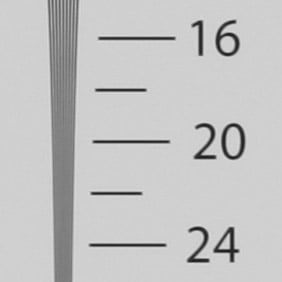 | 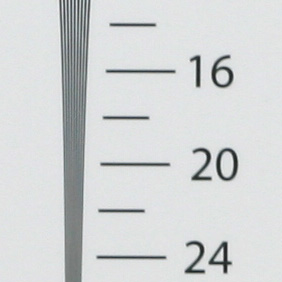 | |
1950 lpph, 85mm, f8, 100 ISO |
1800 lpph, 85mm, f8, 100 ISO | |
Sony Alpha DSLR-A700 with Sony DT 16-80mm |
Canon EOS-5D with Canon EF 85mm f1.8 USM | |
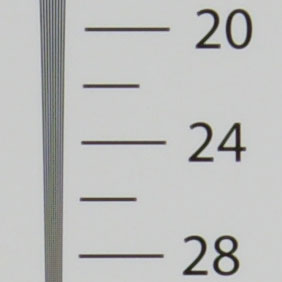 | 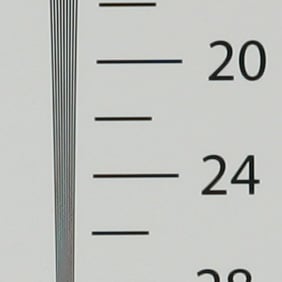 | |
2350 lpph, DT 16-80mm at 35mm, f8, 100 ISO |
2400 lpph, 85mm, f8, 100 ISO |
Canon EOS-40D with Canon EF 85mm f1.8 USM |
Canon EOS-30D with Canon EF 85mm f1.8 USM | |
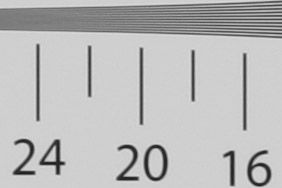 | 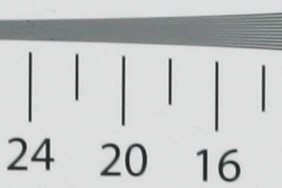 | |
2100 lpph, 85mm, f8, 100 ISO |
1650 lpph, 85mm, f8, 100 ISO | |
Sony Alpha DSLR-A700 with Sony DT 16-80mm |
Canon EOS-5D with Canon EF 85mm f1.8 USM | |
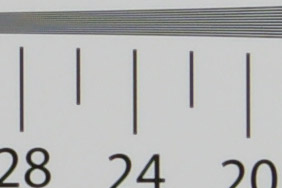 | 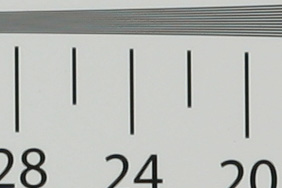 | |
2400 lpph, DT 16-80mm at 35mm, f8, 100 ISO |
2300 lpph, 85mm, f8, 100 ISO |
Canon EOS 40D Studio resolution: JPEG versus RAW
We photographed the test chart in the 40D’s RAW plus Large Fine JPEG mode, allowing us to directly compare images created from exactly the same data. Below are crops taken from the original JPEG file alongside the RAW version, processed in Canon’s Digital Photo Professional 3.1.0.0 software using the default settings (Sharpness of 3). As you can see, the RAW version, even without tweaking, reveals better defined details and a boost in resolving power.
The JPEG file can certainly handle a little additional sharpening, but the RAW result is ultimately preferred. So if you want the crispest detail from the 40D, either increase the in-camera sharpening by a notch, or better still, shoot in RAW. Now let’s check out the camera’s performance at different sensitivities in our Canon EOS 40D noise results page.
Canon EOS-40D JPEG with Canon EF 85mm f1.8 USM |
Canon EOS-40D RAW with Canon EF 85mm f1.8 USM | |
 | 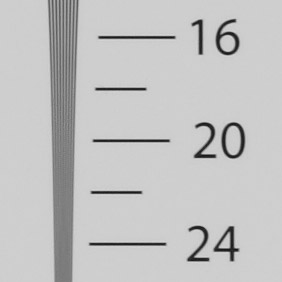 | |
1950 lpph, 85mm, f8, 100 ISO |
2050 lpph, 85mm, f8, 100 ISO |
Canon EOS-40D JPEG with Canon EF 85mm f1.8 USM |
Canon EOS-40D RAW with Canon EF 85mm f1.8 USM | |
 | 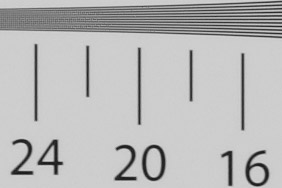 | |
2100 lpph, 85mm, f8, 100 ISO |
2150 lpph, 85mm, f8, 100 ISO |




